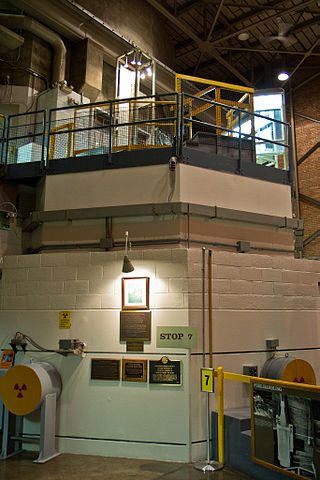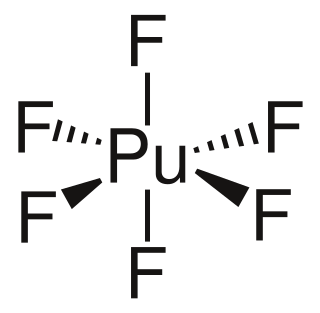
Project Pluto was a United States government program to develop nuclear-powered ramjet engines for use in cruise missiles. Two experimental engines were tested at the Nevada Test Site (NTS) in 1961 and 1964 respectively.

Experimental Breeder Reactor I (EBR-I) is a decommissioned research reactor and U.S. National Historic Landmark located in the desert about 18 miles (29 km) southeast of Arco, Idaho. It was the world's first breeder reactor. At 1:50 p.m. on December 20, 1951, it became one of the world's first electricity-generating nuclear power plants when it produced sufficient electricity to illuminate four 200-watt light bulbs. EBR-I subsequently generated sufficient electricity to power its building, and continued to be used for experimental purposes until it was decommissioned in 1964. The museum is open for visitors from late May until early September.
JASON was a low-power nuclear research reactor installed by the Ministry of Defence at the Royal Naval College in Greenwich, London, now home to the University of Greenwich, to educate and train military and civilian personnel involved in the naval nuclear submarine propulsion.
MOATA was a 100 kW thermal Argonaut class reactor built at the Australian Atomic Energy Commission Research Establishment at Lucas Heights, Sydney. MOATA went critical at 5:50am on 10 April 1961 and ended operations on 31 May 1995. MOATA was the first reactor to be decommissioned in Australia in 2009.

A molten salt reactor (MSR) is a class of nuclear fission reactor in which the primary nuclear reactor coolant and/or the fuel is a molten salt mixture. Only two MSRs have ever operated, both research reactors in the United States. The 1950s Aircraft Reactor Experiment was primarily motivated by the compact size that the technique offers, while the 1960s Molten-Salt Reactor Experiment aimed to prove the concept of a nuclear power plant which implements a thorium fuel cycle in a breeder reactor. Increased research into Generation IV reactor designs began to renew interest in the technology, with multiple nations having projects, and as of September 2021, China is on the verge of starting its TMSR-LF1 thorium MSR.

The Vallecitos Nuclear Center is a nuclear research facility, and the site of a former GE Hitachi Nuclear Energy electricity-generating nuclear power plant in unincorporated Alameda County, California, United States. The facility is approximately 30 miles (48 km) east of San Francisco, under jurisdiction of the US Nuclear Regulatory Commission's Region IV.
Generation IV reactors are nuclear reactor design technologies that are envisioned as successors of generation III reactors. The Generation IV International Forum (GIF) - an international organization that coordinates the development of generation IV reactors - specifically selected six reactor technologies as candidates for generation IV reactors. The designs target improved safety, sustainability, efficiency, and cost. The first commercial Gen IV plants are not expected before 2040–2050, although the World Nuclear Association in 2015 suggested that some might enter commercial operation before 2030.

A high-temperature gas-cooled reactor (HTGR), is a nuclear reactor that uses a graphite moderator with a once-through uranium fuel cycle. The HTGR is a type of high-temperature reactor (HTR) that can conceptually have an outlet temperature of 750 °C (1,380 °F). The reactor core can be either a "prismatic block" or a "pebble-bed" core. The high temperatures enable applications such as process heat or hydrogen production via the thermochemical sulfur–iodine cycle.
The Systems Nuclear Auxiliary POWER (SNAP) program was a program of experimental radioisotope thermoelectric generators (RTGs) and space nuclear reactors flown during the 1960s by NASA.
The Enormous Toroidal Plasma Device (ETPD) is an experimental physics device housed at the Basic Plasma Science Facility at University of California, Los Angeles (UCLA). It previously operated as the Electric Tokamak (ET) between 1999 and 2006 and was noted for being the world's largest tokamak before being decommissioned due to the lack of support and funding. The machine was renamed to ETPD in 2009. At present, the machine is undergoing upgrades to be re-purposed into a general laboratory for experimental plasma physics research.

The Zero Power Physics Reactor or ZPPR was a split-table-type critical facility located at the Idaho National Laboratory, Idaho, USA. It was designed for the study of the physics of power breeder systems and was capable of simulating fast reactor core compositions characteristic of 300-500 MWe demonstration plants and 1000 MWe commercial plants.

The Lady Godiva device was an unshielded, pulsed nuclear reactor originally situated at the Los Alamos National Laboratory (LANL), near Santa Fe, New Mexico. It was one of a number of criticality devices within Technical Area 18 (TA-18). Specifically, it was used to produce bursts of neutrons and gamma rays for irradiating test samples, and inspired development of Godiva-like reactors.
Pyroprocessing is a process in which materials are subjected to high temperatures in order to bring about a chemical or physical change. Pyroprocessing includes such terms as ore-roasting, calcination and sintering. Equipment for pyroprocessing includes kilns, electric arc furnaces and reverberatory furnaces.

Plutonium hexafluoride is the highest fluoride of plutonium, and is of interest for laser enrichment of plutonium, in particular for the production of pure plutonium-239 from irradiated uranium. This pure plutonium is needed to avoid premature ignition of low-mass nuclear weapon designs by neutrons produced by spontaneous fission of plutonium-240.

PRISM is a nuclear power plant design by GE Hitachi Nuclear Energy (GEH).
Shine Technologies, formerly named SHINE Medical Technologies, is a private corporation based in Janesville, Wisconsin. As of February 2016, the company was planning to build a facility to produce radioactive isotopes for medical applications.

The Transient Reactor Test Facility (TREAT) is an air-cooled, graphite moderated, thermal spectrum test nuclear reactor designed to test reactor fuels and structural materials. Constructed in 1958, and operated from 1959 until 1994, TREAT was built to conduct transient reactor tests where the test material is subjected to neutron pulses that can simulate conditions ranging from mild transients to reactor accidents. TREAT was designed by Argonne National Laboratory, and is located at the Idaho National Laboratory. Since original construction, the facility had additions or systems upgrades in 1963, 1972, 1982, and 1988. The 1988 addition was extensive, and included upgrades of most of the instrumentation and control systems.
The Réacteur Universitaire de Strasbourg (RUS) was a 100 kW thermal Argonaut-class reactor built at the University Louis-Pasteur, located in the commune of Schiltigheim near Strasbourg. RUS went critical on 22 November 1966 and ended operations on 31 May 1995. Its decommissioning was finalized in 2009.

The United Nuclear Corporation (UNC) was a diversified nuclear mining, development, and applications company based out of the United States. Formed in 1961 as a joint venture between the Olin Mathieson Chemical Corporation, the Mallinckrodt Corporation of America, and the Nuclear Development Corporation of America, the company is most well known today as the company behind the Church Rock uranium mill spill. In 1996 the company was acquired by General Electric, and remains to oversee the decommissioning of its former sites.











